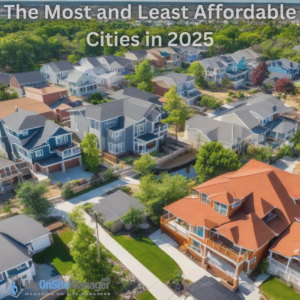In today’s real estate climate, the gap between affordable and unaffordable rental markets across the United States continues to widen. A new study from WalletHub, reported by CNBC, highlights where renters can stretch their dollars — and where they’ll find themselves financially strained. By comparing the median annual rent to the median household income in over 180 cities, the study reveals which markets are the most and least affordable for renters in 2025.
The 10 Most Affordable Cities for Renters
If you’re looking to maximize your rental budget, cities in the Midwest and parts of the Great Plains offer some of the best deals. Here are the top 10 most affordable rental markets:
-
Bismarck, North Dakota
Renters here only spend 15.34% of their median income on rent. Thanks to a balance of relatively high wages and lower housing costs, Bismarck tops the list as the most affordable city for renters in America. -
Sioux Falls, South Dakota
Coming in close behind, renters spend just 15.95% of their income on rent. Sioux Falls benefits from steady economic growth and a reasonable cost of living. -
Cheyenne, Wyoming
With a rent-to-income ratio of 16.09%, Cheyenne offers affordability in a scenic and fast-growing area. -
Cedar Rapids, Iowa
An affordable city where residents enjoy a low cost of living while maintaining good access to jobs and amenities. -
Fargo, North Dakota
A strong local economy and competitive rental market keep rent-to-income ratios low. -
Charleston, West Virginia
The capital city offers a lower cost of living compared to many other East Coast cities. -
Casper, Wyoming
Like Cheyenne, Casper is part of Wyoming’s affordable rental landscape, with housing costs well below the national average. -
Overland Park, Kansas
A suburb of Kansas City, Overland Park combines suburban comfort with urban access at a reasonable price. -
Juneau, Alaska
Surprisingly affordable given its remote location, Juneau has a balanced rental market. -
Anchorage, Alaska
Despite being Alaska’s largest city, Anchorage maintains affordability for many renters.
Key takeaway:
In these cities, renters are able to spend significantly less than the recommended 30% of income on housing, leaving more room for savings, investments, and other living expenses.
The 10 Least Affordable Cities for Renters
Meanwhile, renters in some of America’s biggest and most desirable cities are facing severe affordability challenges. Here are the 10 least affordable rental markets:
-
Miami, Florida
Miami tops the list as the least affordable city for renters — with residents spending an astonishing 33.48% of their median income on rent. The combination of soaring rents and relatively modest median incomes puts heavy pressure on renters. -
Newark, New Jersey
Newark renters spend 32.96% of their income on rent, grappling with high costs despite not being in Manhattan proper. -
New Haven, Connecticut
Known for Yale University, New Haven’s tight rental market drives rent-to-income ratios up to 32.18%. -
Detroit, Michigan
Despite the city’s ongoing revitalization, low median incomes contribute to a high rent burden at 31.35%. -
Glendale, California
Just outside Los Angeles, Glendale combines high Southern California rental costs with average wages, leading to a 29.84% rent-to-income ratio. -
Bridgeport, Connecticut
Another Connecticut city making the list, with residents facing heavy housing burdens. -
Los Angeles, California
LA continues to be one of the nation’s least affordable cities, with sky-high rents eating up significant portions of renters’ paychecks. -
Philadelphia, Pennsylvania
While more affordable than New York City or San Francisco, Philadelphia still puts significant pressure on renters. -
Boston, Massachusetts
High-paying jobs aren’t enough to offset Boston’s extremely high rents for many residents. -
New York, New York
As expected, NYC remains one of the toughest places to afford renting, with median rents continually rising.
Key takeaway:
In these markets, renters often exceed the 30% guideline, which experts warn can strain financial stability, reduce discretionary income, and make long-term financial planning more difficult.
Why Affordability Matters
The report underscores an important truth: where you live dramatically affects your financial flexibility. In cities where rent remains affordable, residents can build emergency savings, invest in retirement, or even save for eventual homeownership. In contrast, renters in high-cost cities often find themselves paycheck-to-paycheck, vulnerable to unexpected expenses and economic downturns.
Affordability isn’t just a personal concern — it’s a broader economic issue. When renters spend a disproportionate amount of their income on housing, consumer spending on other goods and services often declines, impacting local economies.
As WalletHub analyst Cassandra Happe notes:
“In the most affordable areas, a renter might be able to spend less than 20% of their income on housing, leaving much more room for other essentials and for saving toward buying a home.”
Source:
You can read the full CNBC article here:
The 10 Most and Least Affordable Areas to Rent in the U.S. – CNBC

